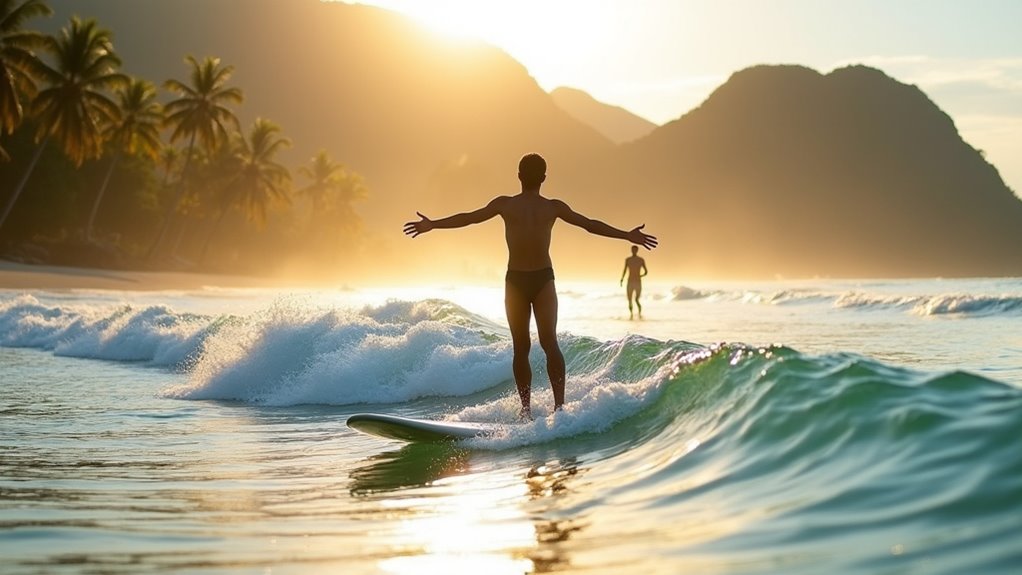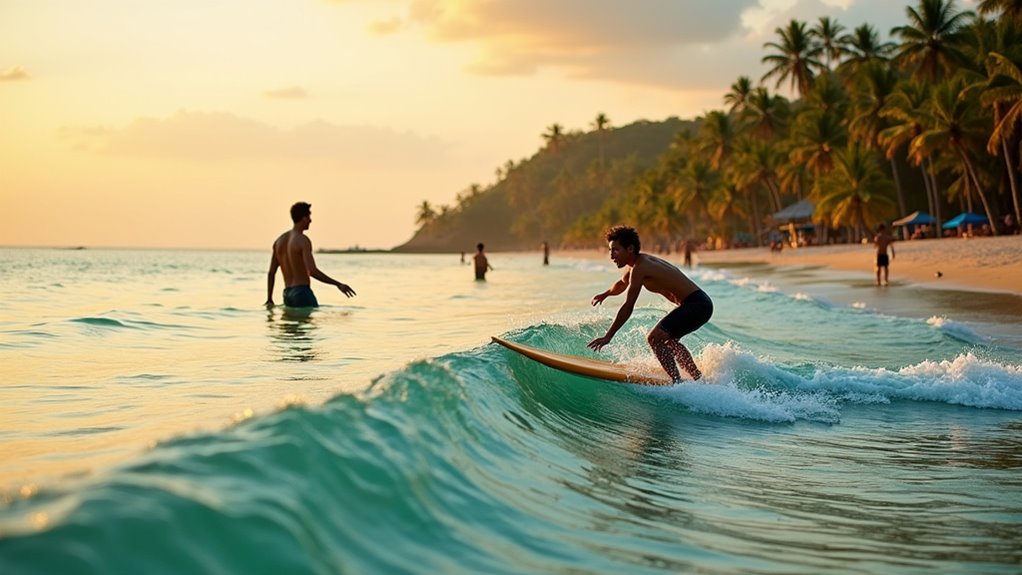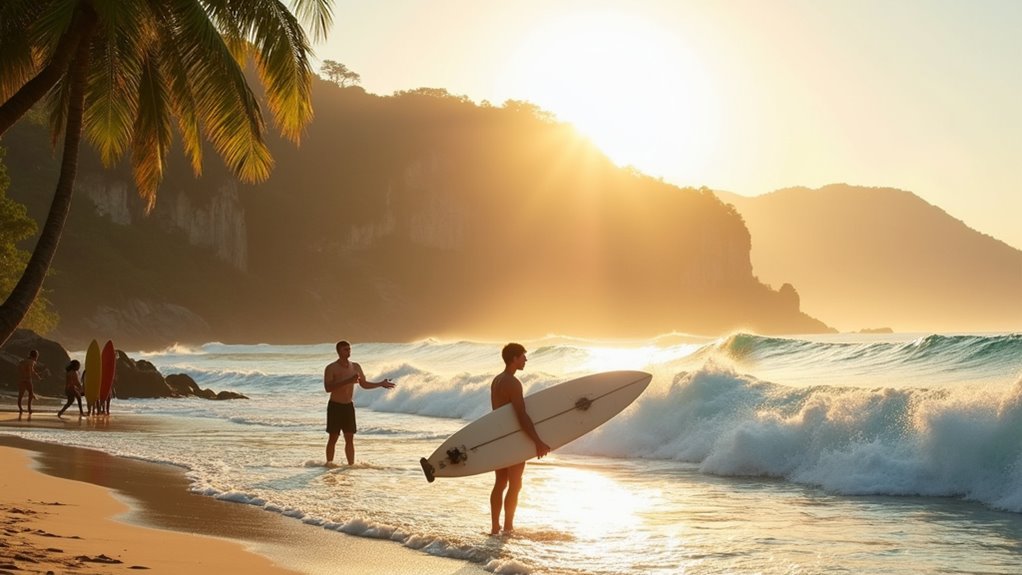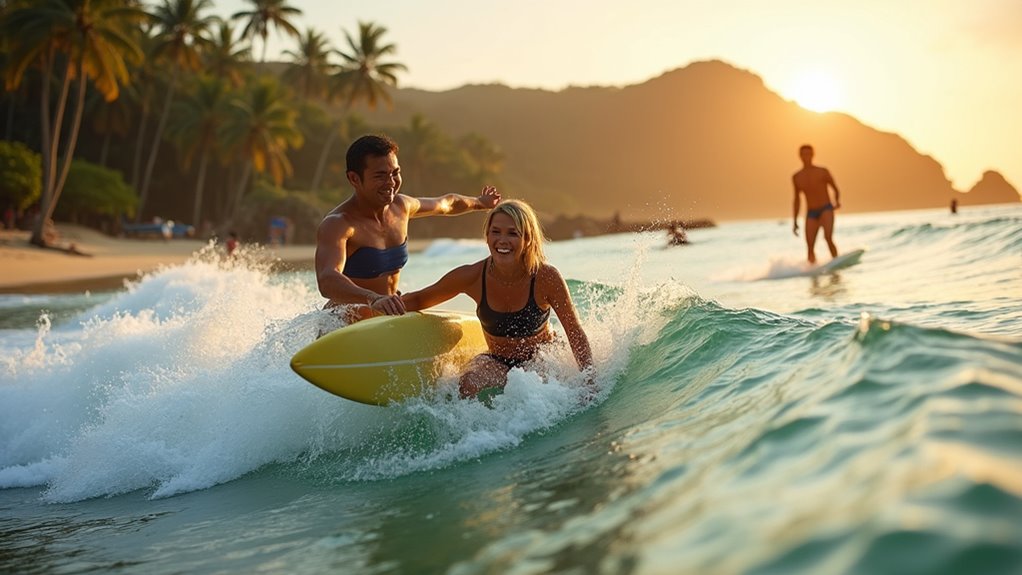Physical Address
304 North Cardinal St.
Dorchester Center, MA 02124
Physical Address
304 North Cardinal St.
Dorchester Center, MA 02124

Magical Thailand welcomes beginner surfers with warm waters and gentle waves across seven pristine beaches perfect for catching your first ride.
Thailand offers perfect conditions for novice surfers with its warm waters, gentle waves, and affordable lessons. Prime spots include Patong Beach with its forgiving sandy bottom, Kata Beach’s consistent 0.5-2 meter waves, and less crowded locations like Koh Lanta’s Long Beach. Visit during the southwest monsoon (May-October) for ideal learning conditions, with June to September providing reliable, beginner-friendly swells. Grab a foam board, find a reputable surf school, and discover why Thailand’s becoming a hidden gem for surf beginners.

While many newcomers to surfing might overlook Thailand in favor of more famous destinations, this Southeast Asian paradise offers ideal conditions for those just starting out. The country’s diverse coastlines provide a variety of wave types suited for different skill levels, particularly along Phuket’s protected beaches.
You’ll find Bang Tao Beach especially welcoming with its naturally sheltered southern end that keeps larger swells at bay. The prime surfing season from May to October delivers consistent, gentle waves that build your confidence without overwhelming you. Thailand’s well-deserved reputation as the Land of Smiles makes it an exceptionally welcoming environment for travelers trying a new sport.
What truly sets Thailand apart is its combination of warm waters, budget-friendly surf schools, and a supportive international community. The beautiful beaches maintain lower crowd levels throughout the year, creating a less hazardous environment for beginners to practice freely. Compared to other Asian surf destinations, you’ll get more value for your money while enjoying quality instruction and Thailand’s renowned hospitality.
Now that you’re ready to catch your first Thai waves, let’s get you properly equipped. You’ll need a foam or soft-top surfboard (7-9 feet long) for stability—rentals are available if you’re not ready to invest $380-1,000 in your own. Don’t forget a surfboard leash to keep your board close during wipeouts.
A wetsuit isn’t always necessary in Thailand’s warm waters, but surf wax is essential for grip. For safety, consider wetsuit booties to protect your feet from rocks and coral. Choosing a leash that matches your board length will provide optimal safety and freedom of movement. Pack a first-aid kit for minor scrapes, and a water bottle to stay hydrated. Thailand offers seven ideal beaches for beginners looking to learn surfing fundamentals in gentler conditions.
Most beginners benefit from surf lessons to master proper technique before heading out solo—it’s worth the investment for a safer, more enjoyable experience.

When searching for your first surfing spot in Thailand, Patong Beach is prominent as the perfect training ground. Its beach break creates fast yet forgiving waves over a sandy bottom, dramatically reducing injury risk compared to reef breaks.
You’ll find surfable conditions 51% of the time, with waves typically ranging from 0.5-1.5 meters—ideal for building confidence. The summer months provide the most consistent experience, with June offering clean surfable waves 1% of the time. After surfing, many visitors continue their Thailand adventure by exploring natural formations like the famous Naka Cave. The northern section near the rocks offers slightly cleaner peaks when the main beach closes out.
Unlike technical breaks that demand specific tide timing, Patong remains rideable throughout all tides. The 30.5°C water temperature means you’ll only need board shorts and a rash vest year-round.
Multiple surf schools and rental shops line the beach, making it effortless to grab equipment and lessons without extensive planning.
Just a short boat ride from Patong, Kata Beach and its smaller neighbor Kata Noi offer the perfect progression for beginners looking to develop their surfing skills.
Kata Beach and Kata Noi provide the ideal playground for novice surfers taking their first steps beyond the basics.
You’ll find waves typically ranging from 0.5 to 2 meters, ideal for learning without feeling overwhelmed.
Both beaches shine during May to October when consistent swells arrive from the southwest. With water temperatures hovering around 30°C, you won’t need a wetsuit.
The mid-tide conditions create a suitable learning environment, especially with offshore northeast winds.
You’ll appreciate the less crowded atmosphere compared to Patong, giving you space to practice. November provides particularly good conditions with 30% clean surf days, though many days may have waves that are too small for advanced surfers.
Several surf schools provide lessons and equipment rentals along both beaches.
After your session, you can enjoy the stunning coastline views and nearby amenities while planning tomorrow’s surf adventure. Unlike the popular Thai island alternatives of Koh Lanta or Koh Samui, these beaches offer a unique surfing experience that can’t be found elsewhere.

While Phuket deservedly claims the spotlight as Thailand’s surfing hub, several other Andaman islands offer excellent beginner-friendly waves worth exploring once you’ve gained confidence.
The west-facing beaches along the Andaman coast catch consistent swells from May to October, with most beginner spots featuring forgiving sand bottoms and waves rarely exceeding 2 meters. Many beginners find these locations ideal for practicing as the less crowded beaches provide better learning conditions than the busier surf destinations. Unlike the Maldives’ atolls, Thailand offers more accessible surf spots with nearby amenities and accommodations for travelers on various budgets.
When you’re ready to venture beyond Phuket, consider:
Selecting the right surf school can make or break your introduction to Thailand’s waves. Look for schools offering programs tailored to your experience level—whether that’s beginner courses covering safety basics and wave selection, or advanced training focusing on maneuvers and turns.
Consider class format carefully. Private lessons provide personalized feedback but cost more, while group sessions offer social learning at lower prices. For kids, dedicated 3-day camps combine fun with fundamental skills. Many of Thailand’s surf camps offer options from 3-day to 10-day programs catering to various schedules and learning goals.
Prioritize safety standards: internationally certified instructors, thorough safety briefings, and quality equipment (soft-top boards for beginners). The best schools conduct lessons in waist-deep water with close instructor supervision. After your morning session, refuel at one of the breakfast spots on Koh Phangan where many surf schools organize post-lesson meals.
Value-conscious surfers should look for package discounts, included equipment, and extras like action photos to commemorate your Thai surfing adventure.

To maximize your surfing experience in Thailand, timing your visit with the monsoon seasons is essential. The southwest monsoon (May-October) brings consistent swells to the Andaman Coast, with June through September offering the best conditions for beginners.
During this peak surfing period, you’ll enjoy:
Don’t worry about the monsoon season deterring your plans—it’s actually when Thailand’s surf culture comes alive. The Andaman Coast offers the most reliable spots, while the Gulf coasts have different seasonal patterns worth considering if you’re planning an extended stay. For those visiting during the dry season (December to March), Koh Phayam island offers smaller, cleaner waves that are perfect for beginners learning to surf. If you’re planning a multi-destination trip, Koh Samui provides excellent post-surfing relaxation opportunities with its stunning beaches and vibrant island culture.
Thailand’s beginner surf scene welcomes you with open arms, warm waters, and forgiving waves. You’ll paddle, you’ll fall, you’ll stand—and you’ll improve faster than you expect. Whether you’re catching your first wave at Patong or perfecting your stance at Kata Noi, these seven beaches offer the perfect playground for your surfing journey. Grab your board, book your lesson, and learn about Thai surf culture.